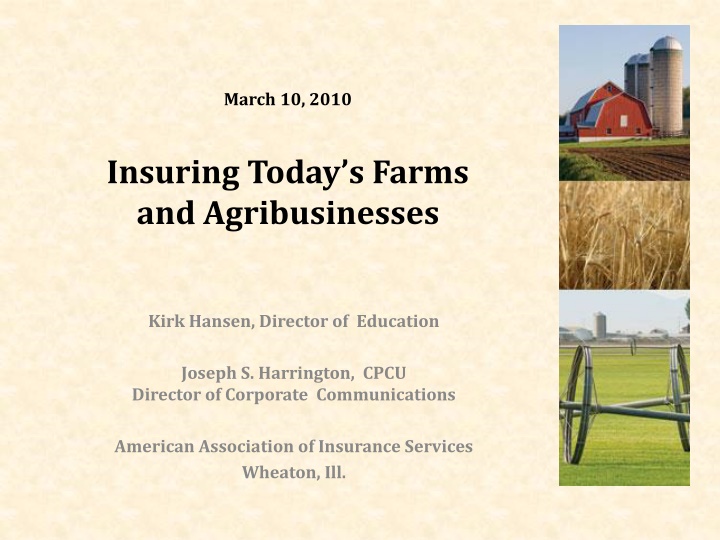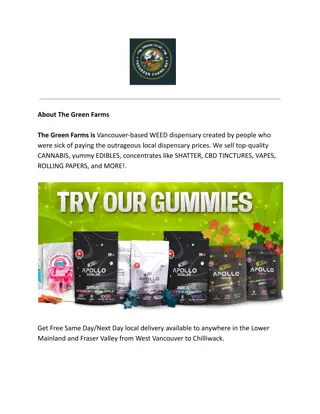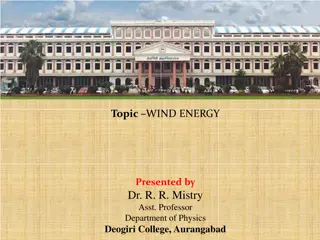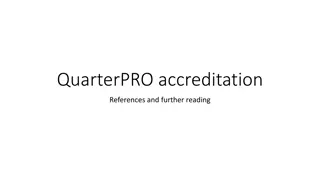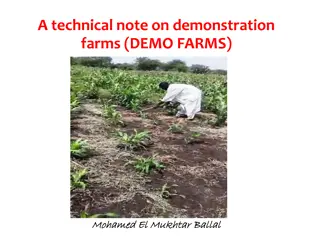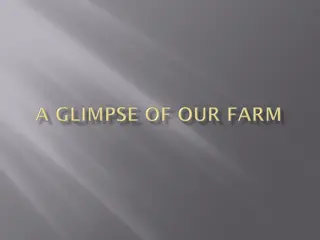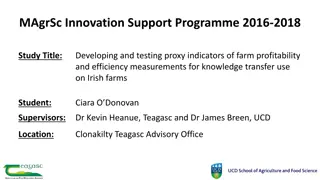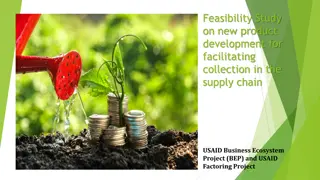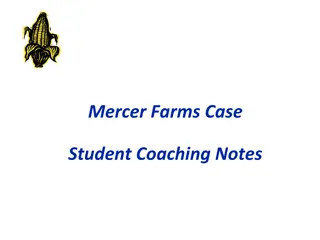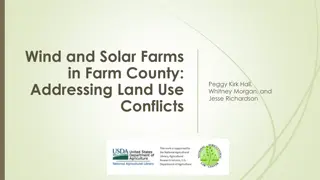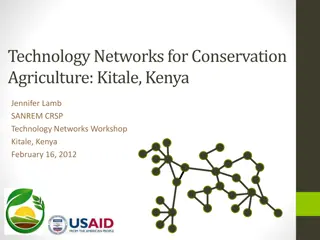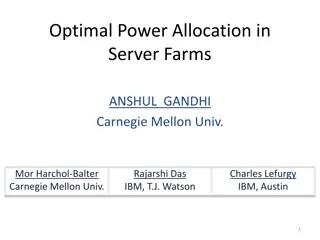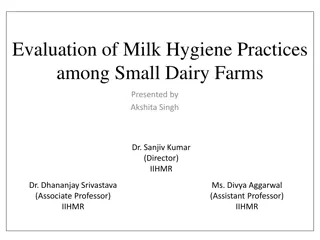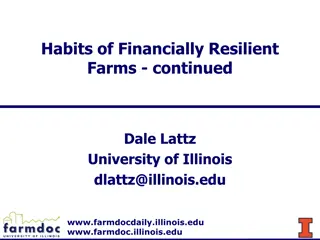Insuring Today's Farms and Agribusinesses Overview
In today's agriculture market, the number of farms has stabilized with increased diversity, ranging from small to large operations. There's a shift towards vertical integration, automation, and a rise in non-farm income activities like agritainment and agritourism. Complex insurance arrangements are needed as operations diversify. Examples like Apple Holler in Wisconsin and Huber's Orchard & Winery in Indiana showcase the multifaceted nature of modern farming enterprises.
Download Presentation

Please find below an Image/Link to download the presentation.
The content on the website is provided AS IS for your information and personal use only. It may not be sold, licensed, or shared on other websites without obtaining consent from the author.If you encounter any issues during the download, it is possible that the publisher has removed the file from their server.
You are allowed to download the files provided on this website for personal or commercial use, subject to the condition that they are used lawfully. All files are the property of their respective owners.
The content on the website is provided AS IS for your information and personal use only. It may not be sold, licensed, or shared on other websites without obtaining consent from the author.
E N D
Presentation Transcript
March 10, 2010 Insuring Today s Farms and Agribusinesses Kirk Hansen, Director of Education Joseph S. Harrington, CPCU Director of Corporate Communications American Association of Insurance Services Wheaton, Ill.
Todays Ag Market 2007 Census of Agriculture Number of farms leveled off About 2.2 million reported in 2007 ag census Small increases after decades of decline Total Number of Farms in U.S. 3500000 3000000 2500000 2000000 1500000 1000000 500000 0 1964 1969 1974 1978 1982 1987 1992 1997 2002 2007 2
Todays Ag Market Growing diversity of farms Increased number of small farms (sales less than $2,500 per year) Increased number of large farms (sales greater than $500,000) Decreased number of mid-sized farms (sales $2,500 to $500,000) Increased number of farms with multiple locations 3
Todays Ag Market, cont. Vertical integration Production and processing happening at the same location Increased capitalization Automation subject to loss, including equipment breakdown Time element exposure Intensification of operations More production, and more risk, per acre Implications for rating Owners still onsite, mostly Exposure for household property Exposure for personal liability 4
Todays Ag Market, cont. Farm income rising faster than farm prices Growing percentage of non-farm income Agritainment and agritourism Sales of finished products Employees or guests? Use of volunteer labor in community-supported agriculture Growing use of contract farming Owner of land, owner of stock, and operator may be different parties Complex insurance arrangements 5
Example Apple Holler, Sturtevant, Wis. At least eight distinct operations: 1. Apple orchard 2. Restaurant 3. Bakery 4. Gift shop 5. Theatre 6. Catering 7. Hayrides 8. Animals 6
Example 2 Huber's Orchard & Winery, Starlight, Ind. 1. U-Pick 2. U-Choose Christmas trees 3. Wine making 4. Wine tasting 5. Wine and liquor store 6. Milk - hard cheese processing 7. Bakery 8. Grocery store 9. Petting zoo 10. Farm tours 11. Gift shop 12. Weddings and parties - including food & drink 13. Liquor manufacturing 7
Insurance product needs Broad range of commercial and agricultural coverages Ease in limiting, adding, or excluding coverages Adequate, flexible rating plans Coverage for personal exposures 8
Traditional farmowners policy Dwelling form Farm property form Farm income and equipment breakdown forms (newer) Farm personal or farm commercial liability form Acreage-based rating 9
AAIS Agricultural Output Program (AgOP) First standardized property program designed for agribusiness Broad property and inland marine coverage built into coverage parts Flexible deficiency point rating plan Eligibility extends to operations that: Buy, sell, store, or process agricultural products; Manufacture goods from agricultural products Sell goods or services to agricultural customers Engage in farming to supply agricultural commodities for manufacturing or processing 10
AAIS AgOP, cont. Three main coverage parts: Property and income coverage Crime Equipment breakdown Dec page entries, not policy language, control . . . Which coverages apply The corresponding limit (entering 0 effectively excludes a coverage) Loss settlement terms (ACV, replacement cost, stated value) 11
AAIS AgOP, cont. Deficiency point rating Rates a risk as a whole rather than as the sum of disparate exposures Deficiency points for risk characteristics Disaster exposure Climatic hazards Special occupancy or production conditions Lack of private protection Inadequate public protection External exposure (neighboring premises) Construction exposures 14
What the AgOP adds . . . . . . to companies that write farmowners An up-to-date product for vertically integrated operations Product for non-farming ag risks . . . to companies that write commercial property A market segment tool with coverages, terms, and options designed for agribusinesses Alternative to modifying commercial forms Minimizes potential coverage gaps Eliminates multiple deductibles 15
AAIS Agricultural General Liability (AgGL) Program First standardized ag GL program 360+ classifications Two base forms; two approaches Farm Commercial Liability Form Designed for farming operations Can be built up by endorsement or dec entry to cover other types of activities Agribusiness Commercial General Liability Form Designed for most agribusiness risks Covers all activities except those excluded Can be scaled back Personal liability coverage available 16
AAIS AgGL, cont. Farm Commercial Liability Form Agribusiness CGL Form Topic Product processing Coverage limited to processing that does not alter the form of products (washing sorting, etc.). Not differentiated from other activities; no restriction of coverage. Farm stands Coverage limited to stands on insured s premises selling insured s products. Business activities Excludes coverage for all business activities not identified on declarations. Agritainment No coverage for ed/rec activities; can be added by dec entry. Can be excluded by endorsement 17
AAIS AgGL, cont. Five principal coverages Coverage L Bodily Injury Liability and Property Damage Liability Coverage M Medical Payments Coverage N Farm Chemicals Limited Liability Coverage O Fire Legal Liability Coverage P Personal and Advertising Injury Liability Farm Chemicals Limited Liability Coverage Provides built-in chemical drift coverage Covers liability for property damage arising from release of chemicals in normal farming operations Does not apply to chemicals released from an aircraft 18
AAIS AgGL, cont. More than 40 exclusions Ag-specific exclusions, including Certain types of fire loss arising from logging or lumbering operations Violations of the Migrant and Seasonal Worker Protection Act Losses from livestock diseases (hoof and mouth and TSE, includes mad cow ) Up-to-date series of commercial exclusions (silica, known injury, etc.) 19
AgGL, cont. Sales-based rating for 64 farm classes Analogous to 1980s introduction of sales- based CGL rating the level of sales of farm products is a better indicator of farm size, since it unambiguously measures economic activity in dollars. U.S. Dept. of Agriculture Insurers may wish to re-consider their traditional reliance on acreage as the primary exposure measure for the liability side of FMP. A switch to average farm revenue can greatly assist in returning this line to a stable underwriting posture MarketStance 20
AgGL, cont. AgGL rating information Converted acreage-based loss costs to sales bases with use of USDA data Commodity Price Stabilization Plan IRPM plan for developing a premium debit or credit based on characteristics of the risk 21
Questions? Kirk Hansen AAIS Director of Education kirkh@AAISonline.com Joseph Harrington AAIS Director of Corporate Communications joeh@AAISonline.com 22
